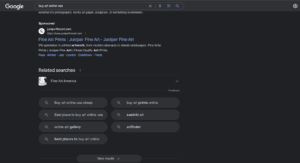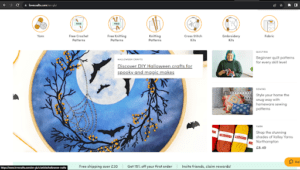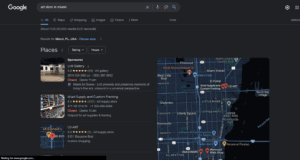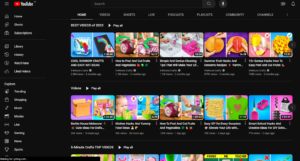Art and craft refers to different kinds of activities that generally involve creating items with one’s own hands. If you think arts and crafts are kid stuff, you are probably wrong. In 2020, the global art and craft market size stood at USD 30.24 billion. From knitting to unicorn slime, every sector of art and craft has seen tremendous growth. If you are a craft businessman or an artist who wants to promote your online business, you cannot afford to miss out on SEO for artists.
Here are the best 5 art and craft websites in the USA:
- Ravelry
- HobbyLobby
- Luma
- The Spruce Craft
- Play Day
You can also rank higher like these art and craft websites with a well-strategized SEO plan for artists. Let’s see what it is and how we can do it.
What is SEO for artists ?
SEO for artists and craft businesses is the technique to boost their website’s online ranking and credibility in the search engine. Artist SEO is a critical aspect of digital marketing for Artists that helps them extend their online reach and increase sales revenue.
Artists can increase their online visibility and draw more organic visitors through the use of appropriate SEO tactics. If you want to optimize your websites for higher rankings in search engine results, creating unique and interesting material that attracts both search engines and users is important. Here, lets discuss some of the best SEO tips for artists:
- Keyword Research for Artist
- Analyzing Competition Levels and Search Trends
- Optimize the website for artist SEO
- Content Creation for Artists
- Local SEO for Artists
- Building Backlinks To Improve Artist SEO Rankings
- Sharing arta content on social media platforms
- Other SEO tips for artist’s websites
Keyword Research for Artist
To optimize your art website and draw in potential consumers, keyword research is an essential step. Artists who want to boost their online exposure and get more visitors to their websites must find high-ranking art-related keywords for website optimization.
Popular art keywords can be skillfully included in website content and meta tags by artists to raise their search engine ranks by identifying their importance and search volume. Increasing traffic from search engines mainly depends on using relevant art keywords in website content and meta tags.
Here are some SEO tips for artist:
- You can create a specific keyword plan to improve your online exposure and boost sales by choosing profitable art-related terms, analyzing competition levels, and understanding search trends in the art sector.
- To find the right keyword for your Art business, use tools such as Google Keyword Planner, Semrush, etc.
- Try to use long tail keywords more often, to stand out from the competition.
- Artists ought to focus on naturally including these target keywords across their pages to optimize website content.
- This includes utilizing them in the text’s body as well as headings, image alt text, and URLs. Search engines will be able to better understand the context and relevance of the artist’s website as a result.
Lets see how we can implement these keywords strategies for Artist SEO.
Identify and use Art-related Terms
Start by creating a list of words and phrases that are relevant to your artwork as you start on your keyword research. Take into consideration the subject, medium, style, and any other distinctive elements of your works.
For instance, “oil painting,” “landscape art,” or “nature-inspired artwork” would be potential art keywords if you specialize in oil paintings of landscapes. It’s time to use keyword research tools to explore deeper once you have a list of basic keywords.
These tools offer detailed information on the level of competition and search volume for particular keywords. They can help you in locating common search terms related to your artistic expertise.
Analyzing Competition Levels and Search Trends
Focus on creating a balance between high demand and moderate competition while examining competition levels for various art keywords. It can be difficult to rank well among professional artists or galleries, with the popularity of highly competitive keywords. So here is what you can do:
- Instead, think about using long-tail keywords, which are more specific phrases with lower search traffic and less competition.
- For example, instead of focusing only on “landscape art,” you can consider narrowing your search to “vibrant oil painting of calm landscapes.” You may reach a smaller, yet more interested audience in this way.
- Pay attention to how people are searching for art. You may modify your content by being aware of what people are searching for at various times of the year.
Targeting Buyer-intent Keywords
Targeting buyer-intent keywords is a must if you want to draw in potential customers who have decided to decide to buy.
- These are phrases that indicate the user’s desire to purchase art or to learn more about doing so.
- For artists, examples of buyer-intent keywords include “buy oil painting,” “affordable landscape art,” or “best place to purchase paintings online.”
- You may boost the possibility of attracting interested customers who are actively looking for artwork by strategically adding these buyer-intent keywords throughout your website, especially in titles, descriptions, and product pages.
Refining Your Strategy with Keyword Research Tools
Tools for keyword research are necessary for improving your keyword strategy. They offer helpful data on search traffic, amount of competition, and similar keywords that can help your optimization efforts.
You can use tools like Google Keyword Planner and SEMrush for proper keywords.
Here are some keywords for artists:
- Buy art online usa cheap
- Best place to buy art online usa
- online art gallery
- best places to buy art online

On Page SEO for Artist
Let’s learn about some tips and tricks to optimize the website for artists:
- Meta tags are really important for artists to provide meta descriptions that successfully describe their work while using relevant art keywords. To motivate users to visit the artist’s website, the meta description serves as a brief overview that appears on search engine results pages (SERPs).
- Targeting specialized niche audiences might be helped by researching long-tail art keywords. Long-tail keywords are more precise phrases with lower search volumes but greater conversion rates because of their narrowness.
- A landscape artist, for example, could use long-tail keywords like “sunset landscape paintings” or “mountain landscape artwork.” Users who are particularly interested in such topics are attracted by these keyword-focused sentences.
Website Optimization for Artist SEO
A website’s navigation, structure, and URLs can all be improved to increase its ranking in search results. The user experience on a website is improved by its design, which also makes it easier for search engines to access and index its content.
These are a few methods for optimizing your website:
- Create URLs with a simple structure that includes appropriate keywords rather than random digits or symbols.
- Since you are an artist, show your creativity in your website design too.
- Easy navigation is guaranteed by grouping or organizing artwork into collections that are accessible through simple options. See how this website has created separate web pages for different art and craft niche. Plus, their design is quite attractive.

- Give appropriate heading to each page. For example, if you have a separate webpage for crochet & knitting wool & yarn, mention it in the heading. In this case your heading can be: Crochet & Knitting Wool & Yarn
- Image optimization: To speed up website loading, compress images without reducing quality.
Effective Use of Meta Tags
When a webpage appears in search engine results, meta tags inform users and search engines together about the subject matter of the page. To increase click-through rates and exposure in search results, artists should optimize meta tags, including title tags and description tags.
Here are some tips for using meta tags correctly:
- Create unique, interesting names for each webpage that include appropriate keywords.
- Write attractive description tags that properly sum up each web page’s content and encourage people to click through.
Responsive Design and Mobile Optimization
A thing to remember: Always optimize your website accordingly so that when somebody opens your website on a phone, the alignment does not get ruined.
Strategies for mobile optimization:
- Put responsive design into practice: To create a design that responds to different screen sizes, use a responsive website theme or consult with a web developer.
- Reduce page load time: For faster loading times on mobile devices, reduce file sizes, and enable browser caching.
Content Creation for Artist SEO
The key for SEO for an artist is the content. It is essential to produce unique attractive content that not only highlights the artist’s work but also benefits visitors.
Artists should concentrate on naturally adding appropriate keywords to all of the pages of their website, including the
To make sure the data is of interest to both search engines and users:
- Run a keyword search: Use resources like Google Keyword Planner or SEMrush to find well-liked keywords associated with the artist’s niche.
- Add long-tail keywords: Include words and phrases that precisely describe the artwork or artistic style.
- Create educational blog posts: Share knowledge about the inspiration behind artworks, the creative process, or other things that are relevant to the target audience in terms of art.
- Add visual components: Use clear pictures and videos of the artwork along with informative subtitles.
Local SEO for Artist
The local search market is a highly profitable opportunity pool for artists. If you are a craft business operating a craft store, local seo might be a boom for your business. It will not only drive more local traffic to your store, but also increase your credibility in the locality.
The top craft store chains in the US are:
- Michaels
- JOANN
- Hobby Lobby
They operate in more than 3,000 locations in the USA.
Here are some tips and tricks for Local SEO for artist:
- Make Google My Business Profile and add all your necessary details such as contact information, address, working hours, email, etc.

- List your craft store in online directories such as Bing Apple Map, ForthSquare, etc. Consider listing in art directories such as: American Craft Council, Art and Craft Collector, etc.
- Participate in local events and exhibitions.
- Make local networks and connections.
- Conduct seminars and workshops for local people.
Building Backlinks To Improve Artist SEO Rankings
It’s important for artists who want to boost their search engine optimization (SEO) ranks to develop a backlink plan. Artists may boost their online presence and drive more traffic to their websites by creating high-quality backlinks from relevant art and craft websites or blogs.
Here are a few tips and tricks to Create backlinks for Artists:
Reaching out to relevant art blogs or publications
Contacting relevant art bloggers or publications is one of the most effective ways to create backlinks. These sites frequently have a large following of art enthusiasts looking to find fresh art.
You can gain major backlinks from these reliable sources by presenting your artwork or posting educational material about your artistic expertise. Make a list of well-known art blogs or periodicals that fit your artistic style or genre to begin.
Create personalized proposals that show why their readership would be interested in your work. And lastly, make sure to highlight the benefits you can offer through original ideas, instructions, or untold stories of your creative process.
Guest posting on art-related websites
The habit of guest posting on websites related to the visual arts is another powerful way to increase visibility and create backlinks. Many people try to attract other artists and collaborate with them. Find them out and make connections with them.
You can get valuable backlinks and establish yourself as a professional in your industry by posting professionally written articles that highlight your expertise and skills. Collaborating with other professionals will make you look professional which will eventually make you and your business website credible. You can consider contact these to get the backlinks:
- Book and Paper Art
- The Metropolitan Museum of Art
- Artsy
- Colossal
Participating in online art communities and forums
Participating in online art forums and communities is not only an excellent way to meet other artists, but it also gives you the chance to grow your backlink profile. You will establish yourself as an expert in your particular artistic field by engaging in discussions while providing insightful feedback.
Other users may then link back to your website or social media profiles as a result of this. Therefore, join online forums and groups where artists meet to exchange ideas, show off their art and crafts, and get feedback. Further, make useful critiques and recommendations based on your personal experiences.
Others are going to be drawn to look at your online presence as you build connections within these forums and may even link back to your website or artwork.
Sharing artist content on social media platforms
Social media platforms are a very important digital channel to boost online presence in today’s age. You can further improve your chances of getting backlinks from individuals who value your creativity by frequently posting your artwork and interacting with your audience on platforms like Instagram, Facebook, or Twitter.
Here are some social media optimisation tips for artist SEO:
- To further optimize their websites with pertinent art keywords, artists should make use of their social media profiles and blog entries.
- Create interesting postings that promote your artwork and add value with insightful details or a glimpse at your creative process.
- Using the right hashtags when posting artwork on social media sites like Instagram or Pinterest can help you reach more people.
Other SEO tips for artist’s websites
Here are some suggestions that can help artists improve the search engine optimization of their websites:
- Listing your art and craft product in third party companies such as Artnet, which is an online forum that facilitates the selling and buying of artwork.
- Using YouTube for marketing your art and craft products.In Fact ‘5 minute craft’ is one the most subscribed Youtube Channels in the world with around 80.3 million subscribers.

To sum up, boosting your artist website’s search engine optimization is necessary for increasing your online presence and attracting more potential customers.
- You can boost the probability that your website will rank higher in search engine results and attract more visitors by including well-liked art keywords in the content of your website.
- Your website’s visibility and organic traffic can be greatly improved by putting into practice efficient SEO tactics including conducting keyword research, optimizing for Google Images, utilizing Wikipedia for discoverability, local SEO and creating backlinks.
- Always remember to provide excellent content that highlights your artwork and attracts website visitors.
You may boost the chance that visitors will become consumers and have more success while selling art online by following these suggestions and staying current with the most recent SEO techniques for artists.
 +1 315 675 4325
+1 315 675 4325  +91-7000226707
+91-7000226707 